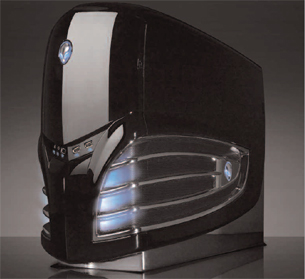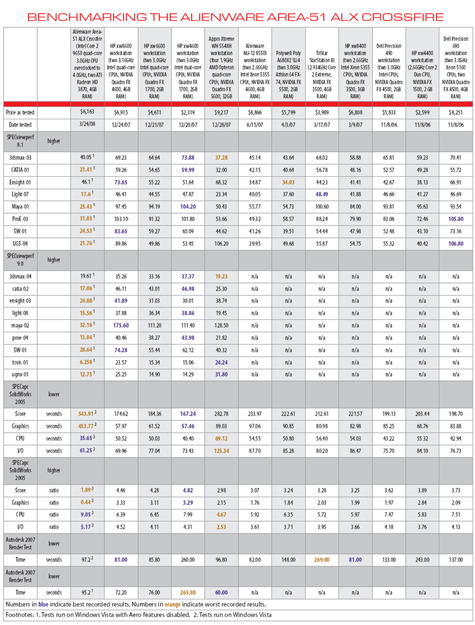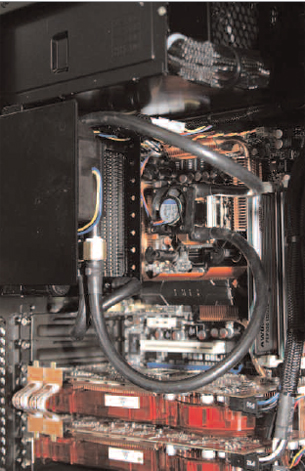Alienware’s Area-51 ALX Crossfire Is a Powerhouse Workstation
Put Alienware's new high-end workstation on your desk for amazing CPU performance.
Latest News
December 4, 2001
By David Cohn
 The Alienware Area-51 ALX Crossfire is stunning in its sinister glossy black case with chrome accentsand LED lighting. Inside beats an Intel Core 2 Extreme Quad-Core CPU overclocked to 4GHz. |
Since we were already familiar with Alienware (see “Out of This World,” DE, September 2007), we thought we knew what to expect when one of the company’s latest workstations arrived for review. The Miami, Florida-based manufacturer, acquired several years ago by Dell, is well-known for its high-performance gaming and professional systems created with the philosophy of “build it as if it were your own.”
But nothing prepared us for what was in the big black carton with the alien logo. The computer that emerged from the beautifully designed packaging looked like nothing less than the stylized spawn of the malevolent creature from the Alien film series. All we needed was for Sigourney Weaver to show up. Control the Color
The Alienware Area-51 ALX Crossfire is strikingly beautiful — unlike any other workstation that we’ve ever seen. It is housed in a glossy black case measuring 9.97 in. x 25.02 in. x 19.01 in. with chrome grills resembling the movie alien’s teeth. The grills wrap nearly to the back of the system, ending in a chrome Alienware logo with glowing eyes. Those grills are also functional, however, as part of the computer’s AlienIce video cooling system. Another chrome Alienware logo on the front panel is actually the power button, power indicator, and hard disk activity indicator (it flashes whenever the drive is accessed). The upper portion of the panel swings open to reveal three external 5.25-in. drive bays, one of which contained an LG 20X DVD+/-RW dual-layer optical drive with Lightscribe technology. Alienware also offers Blu-ray drive options. A second drive bay contained a 28-in-1 digital media reader.
Below the drive bays is a V-shaped panel containing audio line-in and line-out jacks, a FireWire (1394a) port, and two USB 2.0 ports. LEDs behind the Alienware logo, around and behind the hinged drive bay door, below the front panel ports, behind the chrome grills, and inside the alien’s eyes on either side of the case glowed cool blue when we first powered up the system, but we quickly discovered the AlienFX application that gives you control of the color of the LEDS in five different lighting zones. You can set different color combinations and even control flashing of the lights to alert you of new e-mails or other events.
 |
Connections on the rear panel were no less impressive. There we found a single PS/2 keyboard port, a second FireWire connector, both coaxial and optical S/PDIF output ports, two RJ45 LAN ports, six more USB 2.0 ports, two external SATA ports for hot swapping external hard drives, and no less than six audio jacks for the built-in 8-channel high definition audio system: microphone, line-in, line-out/front speaker, side speaker, center/subwoofer, and rear speaker. There is also a pair of antenna connectors for the built-in 802.11n (draft) WiFi, which can run either as a network client or access point. We had no problem connecting wirelessly to our existing LAN.
Lifting a small lever on the tool-less chassis is all that it takes to remove the side panel and access the spacious and well-organized interior. There we found an extended ATX motherboard manufactured by ASUS based on the Intel X38 Express Chipset. This chipset supports up to 8GB of dual-channel DDR3 memory, a 1333MHz front-side bus, dual PCI Express x16 graphics, and multi-core CPUs. The motherboard also provides PCIe 2.0 support, FireWire, SATA transfer speeds of 3Gbps, dual Gigabit LAN, and the HD audio and S/PDIF digital sound.
We also found rubber hoses running from the CPU to an assembly with a 4-in. fan mounted on the rear panel. Rather than relying on a large passive cooling heat sink, the Alienware Area-51 uses an active liquid cooling system with a high-flow circulating pump connected to a heat exchanger to chill the overclocked Intel Core 2 Extreme 9650 CPU. Although rated at 3.0GHz, Alienware boosts the speed of its “Yorkfield” processor (a CPU based on Intel’s 45nm process with High-K metal gate transistors and 12MB of L2 cache) to 4.0GHz.
 The rubber hoses surrounding the CPU are part of an active liquid cooling system tochill the overclocked QX9650 processor. |
Virtual Silence
The motherboard provides four DIMM sockets supporting up to 8GB of dual-channel DDR3 memory. Our evaluation unit came with 4GB of RAM installed as two 2GB 1333MHz memory modules. There are also a total of seven expansion slots: two PCI-Express 2.0 x16 graphics slots, two PCI-Express x1, two standard PCI slots, and a third PCI-Express x16 slot (lacking PCI-e 2.0 support and only x1 or x4 electrically). The two x16 graphics slots were filled with a pair of ATI Radeon HD 3870 graphics boards linked together using ATI’s Crossfire connector, from whence the system gets part of its name. Crossfire is ATI’s answer to NVIDIA’s SLI technology, though ATI targets Crossfire specifically at the gaming community. It enables two or more discrete graphics processors to work together to improve system performance. Each board provides 512MB of onboard video memory and 320 stream processors. The additional power requirements of these boards necessitates an auxiliary connection to the computer system’s power supply, and the large cooling fan and plastic cowl block access to the adjacent expansion slots. So as configured, only one PCI-e x1, one PCI, and the additional PCI-e x16 expansion slots remain available.
The motherboard also provides support for all of the drives, including six SATA connectors with RAID 0, 1, 5, and 10 functionality and two additional connections with RAID 0, 1, and JBOD support. The internal drive cage provides four 3.5-in. drive bays with quick-release acoustic-dampening rails. Our system came well equipped with a pair of 160GB Western Digital 10,000 rpm Raptor drives configured in a RAID 0 array to appear as a single 320GB primary drive and a 1 terabyte (TB) Hitachi Deskstar 7,200rpm drive for data storage.
The 1,000 watt power supply provides ample energy, yet in spite of all the drives, graphics boards, and fans (in addition to those on the graphics cards and CPU cooling system, there’s another 4.5-in. fan in the front panel, a 3.5-in. fan behind the hard drive bays, and a 4.5-in. fan in the side panel), the Alienware Area-51 ALX Crossfire is virtually silent.
Not Quite Out of This World
Of course, you should buy a computer for its performance, not for its great looks, and here the Alienware system proved to be a mixed bag. We loaded up our standard set of benchmarks, but not without some difficulty. First, there was the operating system. Alienware preinstalled Windows Vista, making the Area-51 ALX Crossfire the first workstation we’ve tested on Microsoft’s new operating system. We had to apply a service pack in order to run AutoCAD 2007 on this machine. Second, while the ATI Radeon HD 3870 is an impressive graphics board, it is designed for gaming, not professional 3D and 2D MCAD applications.
Testing Under Vista Now that it’s been around for a while, however, much more is known regarding Vista’s performance. A key feature of Windows Vista is the new Aero interface. According to an article by Ian Williams, a senior application engineer at NVIDIA and chair of the SPECopc project group (the organization responsible for the Viewperf benchmark), “Because Aero is tightly integrated with the GPU, it is essentially a complete 3D application in itself, using much of the GPU’s capabilities and horsepower. Windows Vista’s Desktop Window Manager (DWM) is the underlying architecture and mechanism that enables Aero’s capabilities. Workstations with Windows Vista pre-installed have the DWM and Aero enabled by default.” Because of this, all the OpenGL and DirectX content passes through the DWM. As a result, Aero actually competes with other applications, including Viewperf, for GPU resources. According to OpenGL.org, this impact reduces performance approximately 10 percent. In addition, when running Viewperf under Windows XP, a graphic function known as “vsync” is typically disabled to achieve maximum graphic performance. But in Windows Vista, “vsync is used with all applications, since otherwise the desktop display would tear and that is unacceptable,” says Williams. Because of these differences between the two operating systems, simply turning vsync off on Windows Vista does not have the same effect as it does on XP. In order to more closely compare the Viewperf results between Windows XP and Windows Vista, one would need to turn off Vista’s DWM. But that is not desirable as a real-world working environment, since doing so disables all of the Aero features and, says Williams, “is not representative of how typical users would run applications on Windows Vista.” To see for ourselves, we disabled the DWM, and did note a slight performance gain. We achieved a more significant performance gain, however, when we downloaded an updated version of ATI’s latest Catalyst driver software for Windows Vista. Since we could test only on Windows Vista, and have no previous benchmark results for the ATI Radeon 3870 graphics card, we can’t attest to whether its performance was truly only 10 percent below what it would have been on Windows XP. What we can say is that, based on our benchmark results, the ATI Radeon 3870 is not a card one would choose if one’s primary use was MCAD or digital content creation. Unlike ATI’s FireGL graphics boards, the Radeon cards are not certified for running these professional applications and the Radeon driver is optimized for games and general graphics, not the more demanding needs of MCAD. —D.C. |
Some of the SPEC Viewperf 8.1 datasets returned spurious results, necessitating multiple runs of this benchmark. In spite of any tweaking we attempted, the results were less than impressive. While Viewperf 9.0 ran without issue, the results were similar to the earlier ones, with this Alienware system returning the lowest Viewperf scores of any system we’ve looked at in the past 18 months. But those results weren’t entirely unexpected, considering the nature of the graphics board and the fact that Vista can unfairly impact the Viewperf results (see “Testing Under Vista”).
When we turned our attention to the SPECapc SolidWorks benchmark, which is more of a real-world test (and breaks out graphics, CPU, and I/O performance separately from the overall score), the results were immediately more impressive. While the overall and graphics scores were still at the very bottom, the CPU and I/O results blew the doors off every other system we’ve ever reviewed, no doubt owing to the overclocked CPU and fast hard-drive RAID array.
The AutoCAD rendering results were equally impressive. Since the Mental Ray renderer in AutoCAD is multithreaded, this test clearly shows the benefits of multiple CPUs. So although the Alienware Area-51 lagged behind the HP xw8600, HP xw6600, and the Appro Xtreme WH 5548, we immediately noted that those systems had the equivalent of 8 and 16 CPUs, respectively, while the Alienware system had just four — very impressive indeed.
Equally impressive were all the extras provided by Alienware. Our Area-51 workstation came with an excellent Saitek Eclipse II illuminated keyboard. In addition to volume control buttons on the keyboard, a knob lets you adjust the intensity of the blue LED backlighting. Alienware also included a Logitech G5 Laser Mouse, definitely a cut above more mundane 2-button optical mice. Alienware offers lots of other options, including the even more powerful ATI Radeon HD 3870 X2 graphics board, a media center remote control, additional hard drive options, an Ageia PhyscX PCI-Express processing unit for even greater acceleration of gaming graphics, and several choices of monitors and speakers, as well as software bundles for anti-virus, Microsoft Office, gaming, and digital editing. Each ALX purchaser also receives a cool Alienware mesh cap, mouse pad, keychain, and excellent printed documentation in a nice leather binder, a rarity these days.
Alienware offers a standard one-year warranty with 24/7 phone support and onsite service. Two- and three-year warranties are also available. The company includes AlienRespawn 2.0, a data-recovery DVD that restores the system to its original shipped configuration.
Prices start at $5,149 for a system that’s already very well appointed. The only significant extras on our evaluation unit were an additional 2GB of memory and the 1 TB hard drive, raising the cost to $6,163. Clearly the Alienware Area-51 ALX Crossfire is not going to appeal to everyone. It’s unlikely to find its way into many corporate environments — its appearance alone may be too frightening for the IT department. And the ATI Radeon HD 3870 graphics boards make the system less suitable for high-end MCAD and analysis applications. Still, the Alienware Area-51 ALX Crossfire is a worthy system for digital content creation, and I can see many a home-based worker thinking seriously about putting one of these creatures in his or her office.
More Info:
Alienware
Miami, FL
Alienware Area-51 ALX Crossfire
> Price: $6,163 as tested ($5,149 base price)
> Size: 9.97 in. x 25.02 in. x 19.01 in. tower
> Weight: 54.5 pounds
> CPU: Intel Core 2 Extreme (Quad Core) 9650
3.0GHz (overclocked to 4.0GHz)
> Memory: 4GB DDR3 SDRAM at 1333MHz
> Graphics: two 512MB ATI Radeon HD3870 –
Crossfire Enabled
> Hard Disk: two Western Digital 160GB SATA
1.5Gbps 10,000 rpm drives in a RAID 0 array
(320GB total capacity) 2x16MB cache; one
1000GB 7,200 rpm SATA 32MB cache
> Floppy: none
> Optical: 20X DVD+/-RW Dual-Layer Lightscribe
> Audio: integrated high-definition surround sound
8-channel (7.1) 24-bit audio
> Network: dual integrated Broadcom 5755
NetXtreme Gigabit LAN
> Modem: none
> Other: eight USB 2.0, two IEEE 1394a FireWire,
PS/2 keyboard, two SATA ports
> Keyboard: 109-key Saitek Eclipse II illuminated
> Pointing device: Logitech G5 Laser Mouse
Contributing Editor David Cohn is a computer consultant and technical writer based in Bellingham, WA, and has been benchmarking PCs since 1984. He’s an applications engineer with The PPI Group, and the author of more than a dozen books. Please send comments about this article to [email protected]. You can also contact David at [email protected].
Subscribe to our FREE magazine, FREE email newsletters or both!
Latest News
About the Author
David Cohn is a consultant and technical writer based in Bellingham, WA, and has been benchmarking PCs since 1984. He is a Contributing Editor to Digital Engineering, the former senior content manager at 4D Technologies, and the author of more than a dozen books. Email at [email protected] or visit his website at www.dscohn.com.
Follow DE





